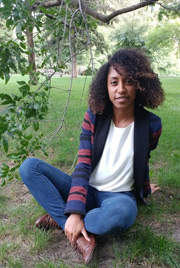Celebrating National Forest Week the Conservation Volunteers way
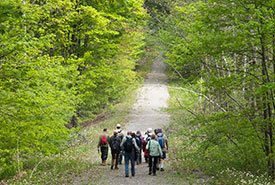
Volunteers heading out to pull invasive garlic mustard at a CV event in Happy Valley Forest (Photo by Miguel Hortiguela)
I grew up near an urban forest in Hamilton, Ontario, on the west side of the mountain. The Niagara Escarpment, recognized by the UNESCO as a World Biosphere Reserve in 1990, runs through the middle of the city, dividing it into what’s known as “the mountain” and “downtown” for Hamiltonians. As a child, living on “the mountain” allowed me to spend quite a bit of time outside, helping me develop an affinity for nature. I used to walk the escarpment’s trails, lined with large white pine and its dense woods filled with sturdy maple and oak. I played with the neighbourhood kids, catching and releasing frogs and turtles in nearby ponds. I’ve hiked along the Bruce Trail, taking in the many waterfalls and landscapes that Hamilton has to offer.
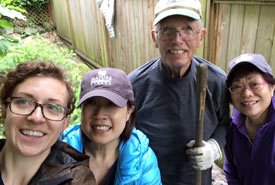
Dick Loomer hosted volunteers at his home to plant trees for Swishwash Island. (Photo by NCC)
Whether you live in an urban or rural area, Canada is covered in forest. As Canadians, we’re fortunate that approximately 35 per cent of the country is forested. Whether you like to visit forests to exercise on nature trails, walk your dog or simply connect with nature, there are opportunities for everyone to enjoy their natural beauty and purity.
The Nature Conservancy of Canada’s (NCC's) Conservation Volunteers (CV) program works across the country to protect Canada’s forests. Here are some of the ways our CVs have helped trees this year:
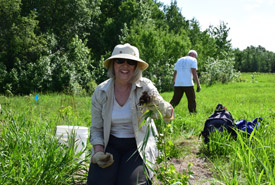
Volunteer at Gambling Lake, AB (Photo by NCC).
Stopping the spread of invasive species
In almost every province this year, CVs have removed invasive species to help trees and native plant species breathe. From invasive blackberry bushes in Surrey, British Columbia, to persistent garlic mustard in Ontario’s Happy Valley Forest, our volunteers have tackled it all.
Stopping invasive species from spreading is critical in preventing them from taking over native plant communities. Volunteers in Quebec worked together to remove invasive common buckthorn near Lake Champlain, while CVs in Alberta teamed up to continue the ongoing control of invasive creeping thistle and sow thistle in the beautiful open meadows of Clifford E. Lee Nature Sanctuary.
Creating wildlife habitats with native plants
NCC volunteers have helped create healthy natural systems by planting native plants to create lush wildlife habitat. CVs in Alberta planted native flowers and herbs, contributing to a pollinator restoration project on NCC’s Gambling Lake property. Pollinators, such as bees, help sustain Canada’s forests by pollinating wild plants and flowers. CVs also installed tree cages on newly planted shrubs to protect them from hungry mammals.
Plantings trees, of course!
NCC’s volunteers have planted and helped monitor the health of trees in forests across the country. Some of their accomplishments include:
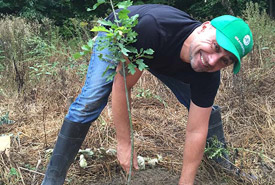
Conservation Volunteer planting a tree in Happy Valley Forest, ON (Photo by Mimi Chan)
- Transplanting Douglas-fir seedlings to pots in preparation for planting in Richmond, British Columbia.
- Monitoring the health of re-vegetation zones for newly planted trees in Spruce Grove, Alberta.
- Planting trees along the Nottawasaga River in Ontario’s internationally significant Minesing Wetlands.
- Planting native trees and shrubs to help restore a riparian forest near the Grondines swamp in Quebec.
- Planting red spruce, red oak and white pine seedlings along the Chignecto Isthmus in New Brunswick to restore the area’s natural forest habitat. By restoring the area, CVs helped to encourage wildlife, such as moose, Canada lynx and bobcat, to cross between New Brunswick and Nova Scotia.
There are many more opportunities to help Canada’s trees this year. Take a look at our event calendar at conservationvolunteers.ca to see how you can help contribute to conservation in your area.

